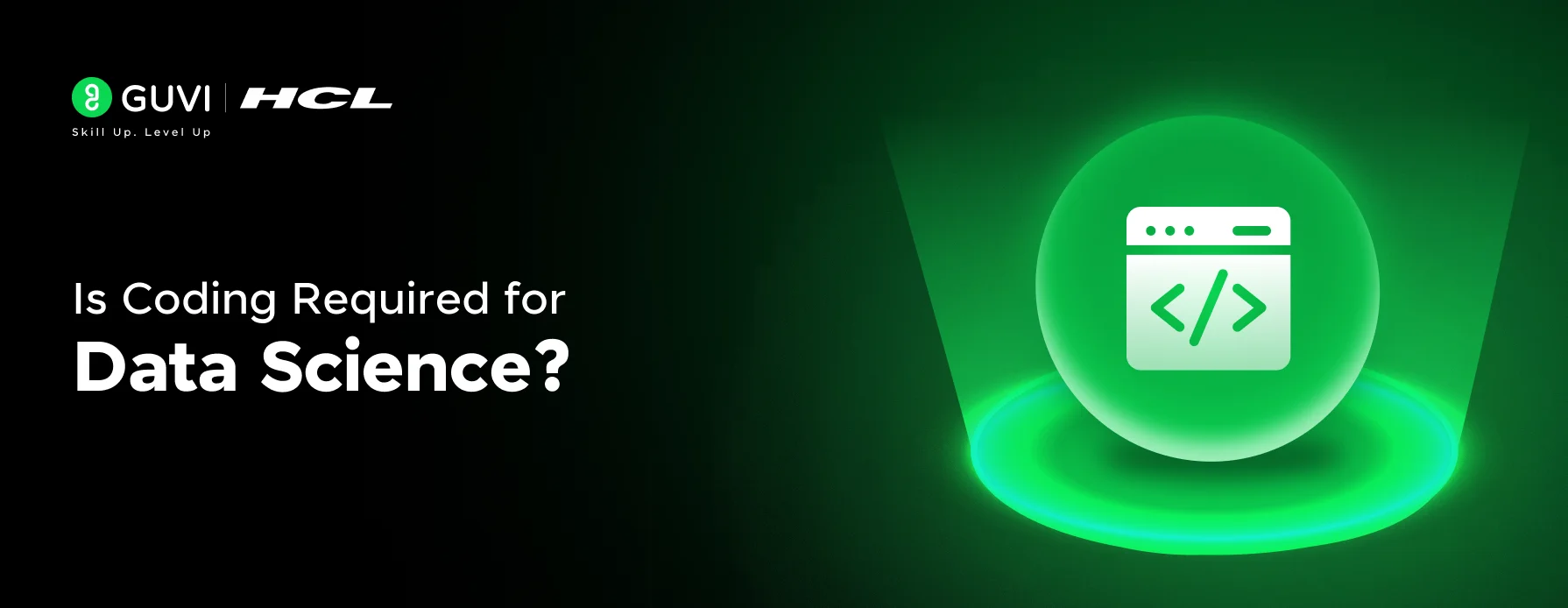
We’ve all wondered at least once, ‘Could I become a Data Scientist?’ and then we start googling about the hows and the salaries and then the most important question: Would I need to know how to code to become a data scientist? This trail has led you here, to us!
Well, the answer to “Is coding required for Data Science?” is YES! While a very high level of coding like that required for software developers is not essential for Data Science, if you ask me, “How much coding is needed for data science?” the answer will change depending on the job role.
Well, the golden thumb rule is that coding is not required to get started in Data Science. However, you can learn it in the process of mastering Data Science for specific tasks alone. But coding is always a plus!
Let’s discuss all the whys and hows below:
Table of contents
- Why is Coding Required for Data Science?
- How Much Coding Do Different Data Science Roles Require?
- Data Analyst
- Data Scientist
- Machine Learning Engineer
- Data Engineer
- Comparison of Coding and Tool Requirements by Role
- Key Programming Languages and Tools in Data Science
- Getting Started: Tips to Learn Coding for Data Science
- So, is coding required for Data Science?
- Conclusion
- FAQs
- Can you be a data scientist without coding?
- Is Python required for data science?
- Is data science a lot of math?
- What should I study to become a data scientist?
Why is Coding Required for Data Science?
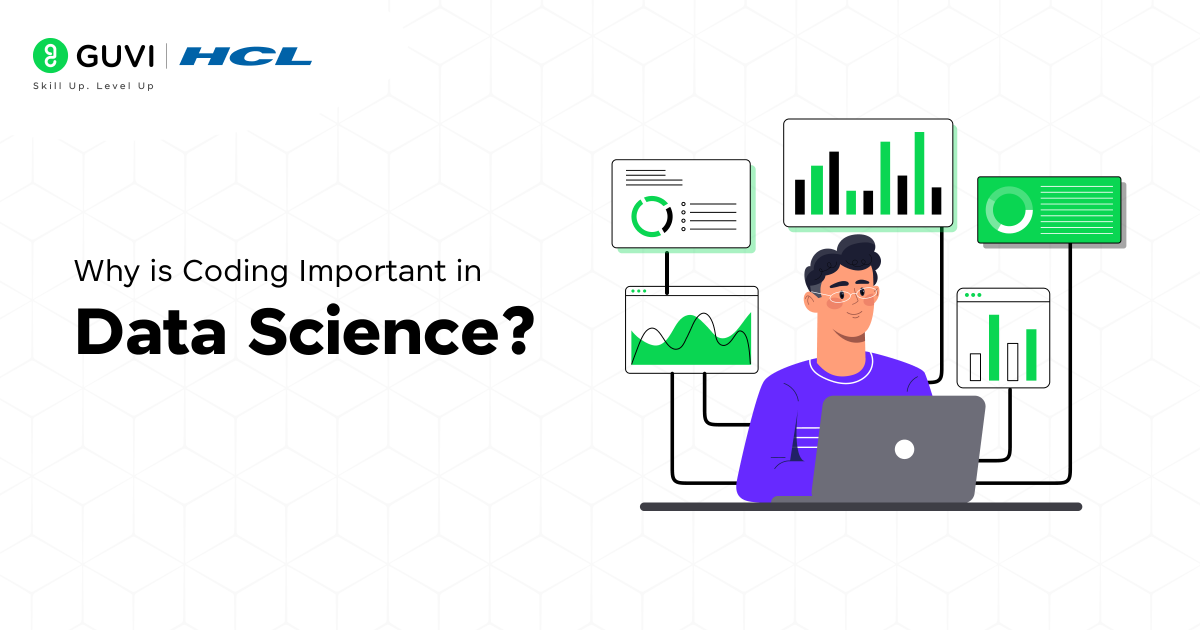
The answer is YES! While a very high level of coding, like that required for software developers, is not essential for Data Science, coding remains an integral part of the field. However, the amount of coding needed varies depending on the job role.
Coding isn’t just about writing software in data science, it’s the toolset that turns raw data into useful insights. Here are several reasons why coding is required for data science:
- Data Collection & Preprocessing: Real-world data is often messy and scattered across sources. Coding skills are crucial for gathering data (via databases, APIs, web scraping, etc.) and cleaning it up.
- Data Analysis & Modeling: The core of data science is analyzing data to extract patterns and building predictive models. This requires coding to apply statistical methods and machine learning algorithms.
- Data Visualization: Communicating insights effectively often means creating charts and dashboards. Coding allows data scientists to craft custom visualizations using libraries like Matplotlib, Seaborn, or Plotly.
- Automation & Reproducibility: Data projects often involve repetitive steps (for example, re-running an analysis on new data). Coding enables automation of these tasks as you can write scripts to fetch data daily, retrain models, or update reports automatically.
In short, coding empowers data professionals to handle data efficiently at scale.
How Much Coding Do Different Data Science Roles Require?
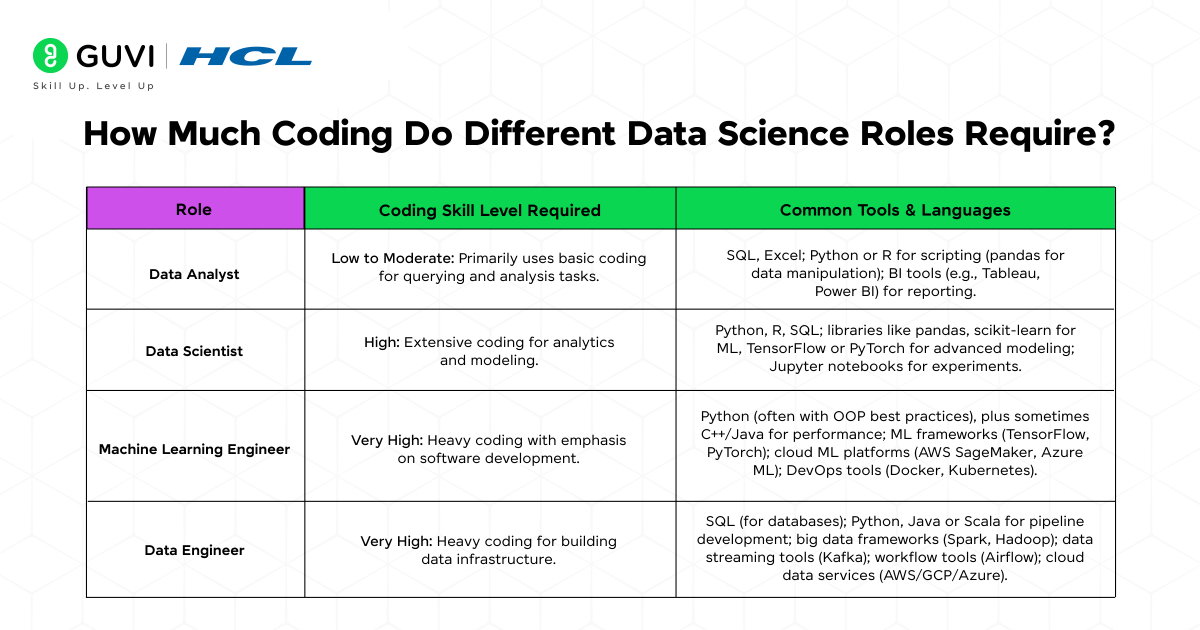
Data science is a broad field, encompassing roles from business-focused analysts to deep technical engineers. All jobs in data science require some coding knowledge, but the amount and complexity of coding vary by role.
Let’s break down the coding requirements for some common data science job titles:
Data Analyst
Data Analysts examine well-defined datasets to spot trends, create reports, and support business decisions. They often answer questions like “What happened and why?” using historical data.
Coding Requirements:
For data analysts, coding tends to be on the lighter side compared to other data roles. They primarily need to query databases (e.g., using SQL) and do basic scripting for data cleaning and analysis.
Many tasks can be accomplished with tools like Excel or BI software, but knowing how to write code makes an analyst far more efficient and self-sufficient. Data analysts use coding to filter and transform data, automate repetitive calculations, and produce visualizations or dashboards.
Typically, they have basic coding fluency in languages like SQL, Python, or R, enough to manipulate data and generate insights but not necessarily to build complex algorithms from scratch.
Data Scientist
Data Scientists dig deeper into data to make predictions and inform strategic decisions. They ask more open-ended questions like “How can we predict or optimize for the future?” This involves advanced techniques in statistics and machine learning, working with both structured and unstructured data.
Coding Requirements:
A data scientist’s coding load is typically heavier and more advanced than a data analyst’s. In fact, “the main difference between a data analyst and a data scientist is heavy coding”
Data scientists regularly write code to experiment with different machine learning algorithms, train models, and iterate on them. They need to be comfortable with more complex programming concepts (writing functions, optimizing code, understanding algorithms) and often work with multiple languages and tools. Most data scientists are proficient in Python (the most popular data science language) and/or R, and they often use SQL for data querying.
They also leverage libraries and frameworks extensively – for example, using pandas for data wrangling, scikit-learn or TensorFlow for machine learning, and perhaps Spark or Hadoop for big data processing.
Machine Learning Engineer
A Machine Learning Engineer (ML Engineer) takes the predictive models and algorithms (often developed by data scientists) and turns them into production-ready systems. This role is a blend of software engineer and data scientist, concerned with not just developing models but deploying, optimizing, and scaling them so they work in real-world products or services.
Coding Requirements:
ML Engineers are highly code-intensive in their work. They need excellent software engineering skills on top of understanding machine learning. There is a strong emphasis on writing efficient, maintainable code because ML engineers integrate algorithms into larger applications.
They also use frameworks and tools for model development and deployment, for instance, coding with TensorFlow or PyTorch to implement neural networks, using libraries for data pipeline (like Apache Beam or Kafka streams), and working with cloud ML platforms (such as AWS SageMaker, Azure ML, or Google Cloud AI).
Data Engineer
Data Engineers design and maintain the data architecture that data analysts and scientists rely on. They build data pipelines to gather data from various sources, transform it, and store it in accessible formats (data warehouses, data lakes).
They ensure that clean, reliable data is available for analysis and modeling. Essentially, they focus on the “plumbing” of data – making sure data flows where it needs to go.
Coding Requirements:
Data Engineers are typically the most programming-heavy of all these roles, often on par with or more than ML Engineers. Their job is akin to software engineering but specialized in data ecosystems.
Data engineers use multiple programming languages and tools: for example, they might write complex SQL queries and also code in Python, Java, or Scala to build pipeline logic. A data engineer’s daily work might include writing scripts to move data between systems, optimizing database performance, or developing APIs for data access.
They also frequently use big data frameworks (like Apache Spark or Hadoop) and workflow orchestration tools (like Airflow), which require writing code or configuration. In summary, coding is at the heart of data engineering and without it, one cannot manipulate and manage large-scale data systems effectively.
Comparison of Coding and Tool Requirements by Role
To summarize the role-specific differences, here is a comparison of coding skill level and common tools for each role:
| Role | Coding Skill Level Required | Common Tools & Languages |
| Data Analyst | Low to Moderate: Primarily uses basic coding for querying and analysis tasks. | SQL, Excel; Python or R for scripting (pandas for data manipulation); BI tools (e.g., Tableau, Power BI) for reporting. |
| Data Scientist | High: Extensive coding for analytics and modeling. | Python, R, SQL; libraries like pandas, scikit-learn for ML, TensorFlow or PyTorch for advanced modeling; Jupyter notebooks for experiments. |
| Machine Learning Engineer | Very High: Heavy coding with emphasis on software development. | Python (often with OOP best practices), plus sometimes C++/Java for performance; ML frameworks (TensorFlow, PyTorch); cloud ML platforms (AWS SageMaker, Azure ML); DevOps tools (Docker, Kubernetes). |
| Data Engineer | Very High: Heavy coding for building data infrastructure. | SQL (for databases); Python, Java or Scala for pipeline development; big data frameworks (Spark, Hadoop); data streaming tools (Kafka); workflow tools (Airflow); cloud data services (AWS/GCP/Azure). |
Key Programming Languages and Tools in Data Science
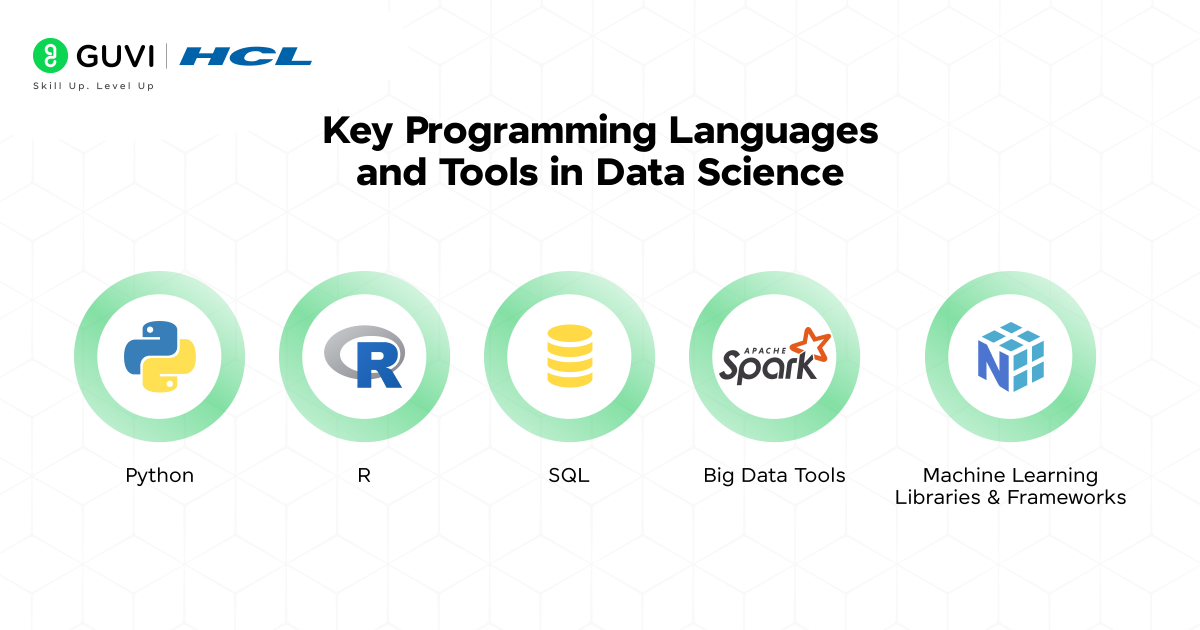
No matter the role, certain programming languages and tools are extremely common in data science:
- Python: Python is the dominant language in data science, known for its readability and an enormous ecosystem of libraries. It’s the most preferred language for data tasks due to its ease of use and community support.
- R: R is another popular language especially in academic and research contexts, and in industries like bioinformatics or finance. R was built for statistics, so it has great packages for analysis (like dplyr, ggplot2 for visualization, and many specialized packages for statistical modeling).
- SQL: SQL (Structured Query Language) isn’t a general-purpose language, but it is essential for data science when it comes to working with databases. Almost every data science job will involve pulling data from a database or data warehouse using SQL.
- Big Data Tools: As data grows, tools like Apache Hadoop and Apache Spark become important. These frameworks allow the distributed processing of large data across clusters of machines.
- Machine Learning Libraries and Frameworks: Data scientists and ML engineers rely on numerous libraries to implement algorithms quickly. We’ve mentioned a few: scikit-learn (for classical machine learning algorithms), pandas (for data manipulation), NumPy (for numerical computing), Matplotlib/Seaborn (for plotting). For deep learning, TensorFlow and PyTorch are the leading frameworks. However, these require coding in Python to define neural network architectures and train models.
Remember, tools evolve – a decade ago SAS was huge for data analysis; now Python/R are king. Tomorrow, there might be new languages or platforms, but if you have solid coding fundamentals, you can adapt to new tools more easily.
Getting Started: Tips to Learn Coding for Data Science
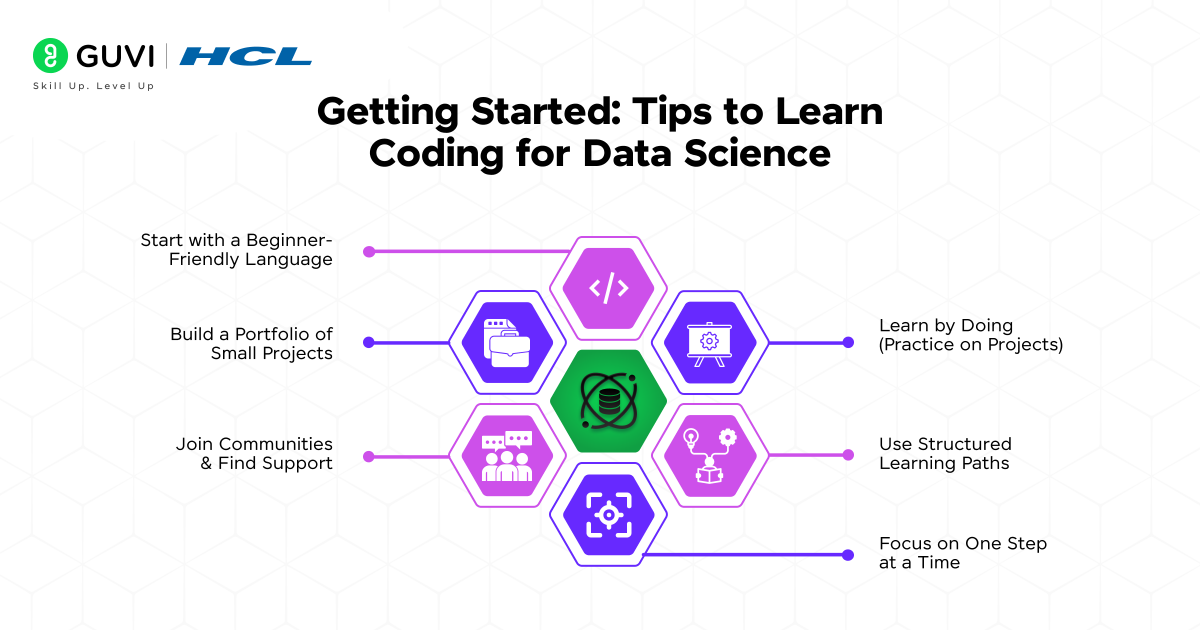
Feeling a bit intimidated by the coding aspect? That’s normal, as many people who ultimately became successful data scientists or analysts started with little to no coding background.
The key is to start small and be consistent. Here are some encouragements and next steps if you’re hesitant about coding:
- Start with a Beginner-Friendly Language: Python is widely considered one of the easiest programming languages to learn for beginners, yet it’s powerful enough to handle advanced data science tasks. Its syntax is clean (for example, printing “Hello World” is as simple as print(“Hello World”)).
- Learn by Doing (Practice on Projects): The best way to learn coding is to write code. Begin with small projects that interest you. For example, if you like sports, try analyzing players’ stats from a CSV file using Python.
- Use Structured Learning Paths: While self-practice is vital, a structured curriculum ensures you cover all fundamental topics.
- Focus on One Step at a Time: Data science is a broad field – you might feel overwhelmed seeing everything you could learn. Remember that you don’t need to learn everything at once. It’s perfectly fine to start with just one language (again, Python is a solid choice) and one area of application.
- Join Communities and Find Support: You’re not alone on this learning journey. There are numerous communities (both online and offline) where beginners and experts mingle. Websites like Stack Overflow are great for getting coding questions answered.
- Build a Portfolio of Small Projects: As you learn, keep track of your projects – no matter how small. This serves two purposes:
(1) It’s incredibly motivating to see how far you’ve come (your early code versus later code), and
(2) It becomes a portfolio you can show to potential employers or include in your resume.
Remember, every expert was once a beginner. Many professionals currently in data science started from a non-programming background – they might have been economists, business majors, or psychologists who gradually learned to code because they saw the value it brought to their work.
In case you want to learn more about how to get started with Data Science, consider reading GUVI’s free Ebook: Master the Art of Data Science which covers every essential topic you need to excel in Data Science, along with real-world examples and hands-on projects to enhance your learning.
So, is coding required for Data Science?
Absolutely! While you can start learning Data Science without coding, gaining coding skills is essential as you advance in your career. Coding allows you to automate tasks, customize your analyses, and handle complex data operations more efficiently.
If you’re aspiring to become a Data Scientist but are worried about the coding aspect, don’t worry! Many comprehensive Data Science programs start with zero coding knowledge and guide you through learning everything you need to succeed in this exciting field.
If you want to learn Data Science through a structured program that starts from scratch and slowly teaches you everything about the subject, consider enrolling in GUVI’s IIT-M Pravartak Certified Data Science Course which empowers you with the skills and guidance for a successful and rewarding data science career
Conclusion
In conclusion, coding and data science go hand in hand. From this article, you’ve seen that while coding is undeniably a crucial skill in data science, the depth of coding varies across roles – from the data analyst who might write simpler queries and scripts, to the machine learning engineer who builds complex software systems around algorithms.
No matter the role, learning to code opens up a world of possibilities in data science that simply isn’t accessible with point-and-click tools alone. It enables you to customize analyses, tackle big and unstructured data, and build intelligent models that drive decisions.
FAQs
Yes, but coding skills significantly enhance a data scientist’s ability to analyze data, automate tasks, and build models. Non-coding tools exist, but coding is highly recommended.
Python is a must for data science as it is the most popular and versatile language due to its extensive libraries, ease of use, and strong community support.
Yes, data science relies heavily on math, particularly statistics, linear algebra, and calculus, to develop models, analyze data, and derive insights.
Study a combination of mathematics, statistics, programming (especially Python), machine learning, and domain-specific knowledge to build a strong foundation in data science.
















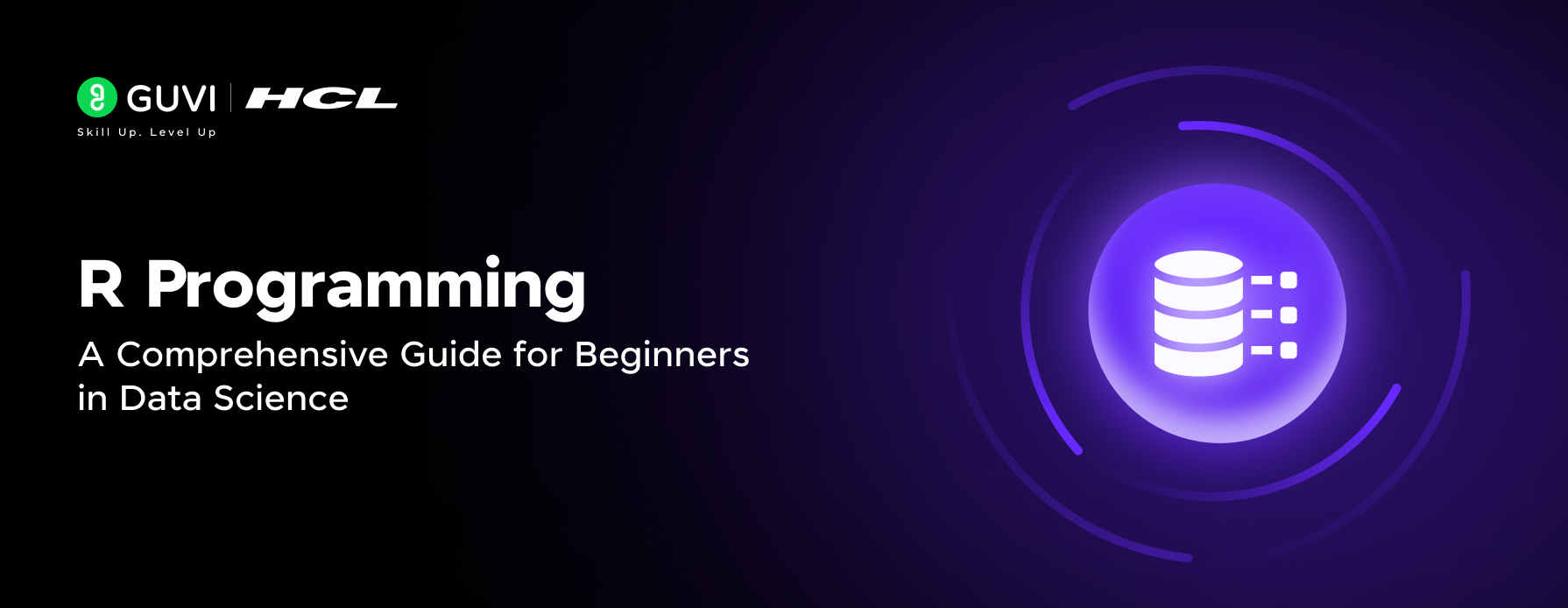

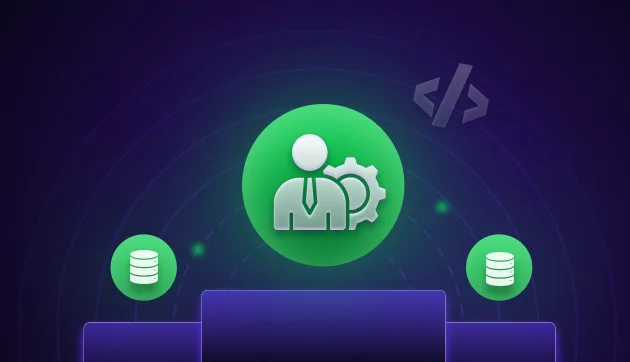



![Top 10 Mistakes to Avoid in Your Data Science Career [2025] 8 data science](https://www.guvi.in/blog/wp-content/uploads/2023/05/Beginner-mistakes-in-data-science-career.webp)


Did you enjoy this article?